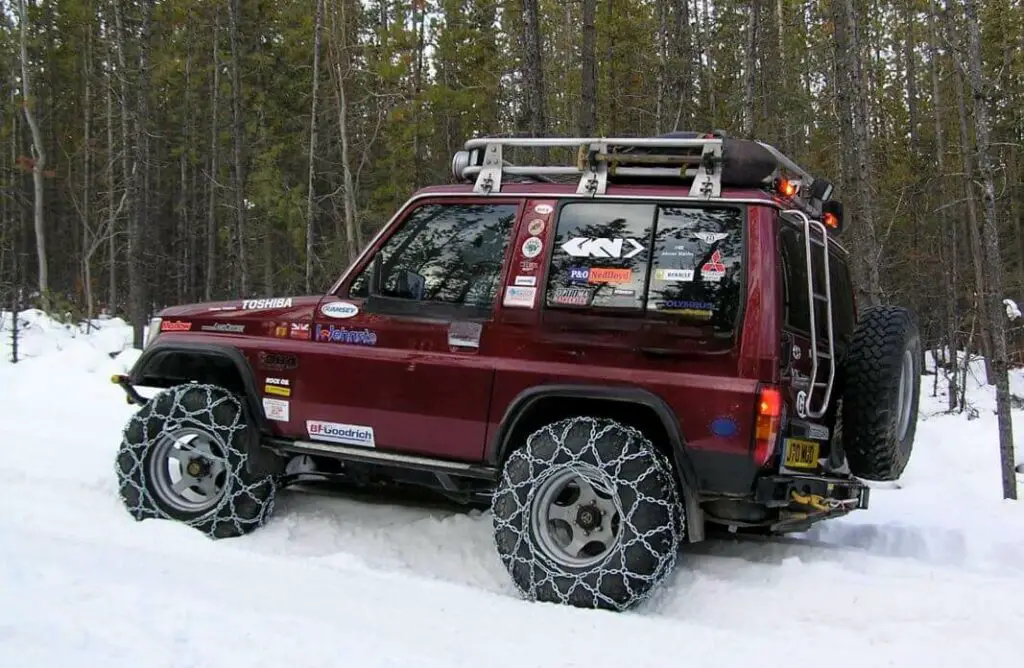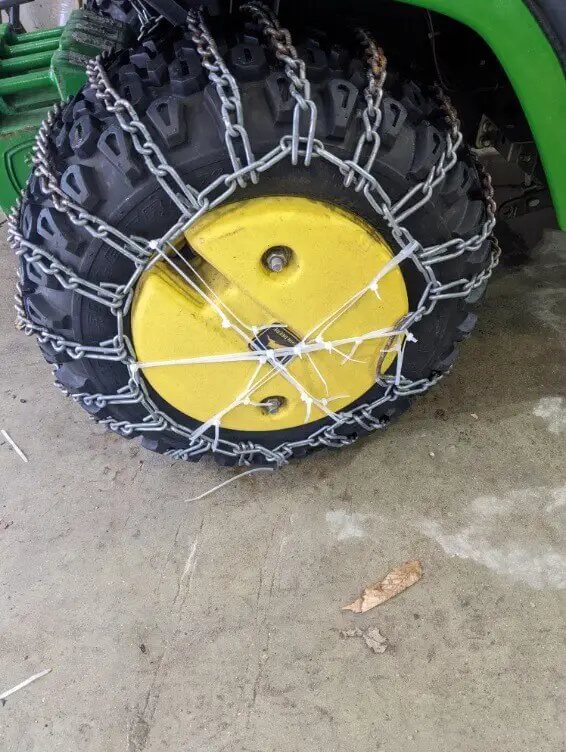Let’s cut to the chase: Do tire chains have to be exact size? You’ve likely pondered this question while preparing for a snowy drive. This guide will not only answer your question but will also shed light on the importance of correct sizing. Buckle up as we take you on a journey into the realm of tire chains and their sizing.
Tire chains are a must-have when driving on icy or snowy roads. But, many drivers don’t know the importance of using the right size. So, let’s look into this!
Using the correct size of tire chains is a must. If not, it can lead to decreased control and increased chances of accidents. It can also damage other parts of the vehicle due to strain or rubbing against wheel wells.

To find the right size, refer to the vehicle’s user manual or ask a tire chain retailer. You can also measure your tire’s dimensions and match them with manufacturer’s sizing charts.
When buying tire chains, select those that are adjustable. This way, you can use them for different vehicles and avoid issues due to slight differences in tire sizes.
Do Tire Chains Have to Be Exact Size?
Yes, it’s recommended that the tire chains size be an exact match with your vehicle’s tire dimensions. Utilizing the appropriate size ensures not only the safety and performance of the vehicle during snowy conditions but also prevents potential damage to the tires and the vehicle’s suspension system.
Also, it’s crucial to consult a tire chain size chart or a snow chain size calculator to find the perfect fit. Always follow manufacturer recommendations to maintain optimal safety and performance.
Tire chains are a must-have for roads covered in snow or ice. But why do tire chains have to be the exact size? Here’s the detailed explanation on why they need to be size-perfect:
- Fitment: Chains need to fit snugly around the tyres. This makes them effective at providing traction.
- Clearance: If the chains are too big, they can rub against vehicle parts. This can damage the wheels, brake lines or suspension.
- Handling: Oversized chains can make steering and braking harder, increasing the risk of accidents.
- Durability: Too-big chains can stretch, break or wear out quickly.
- Performance: The right-sized chains will evenly distribute traction across all four tyres.
- Safety: Poorly-fitted chains can lead to loss of control and damage other vehicles.
Plus, using wrong size chains can get you into legal trouble. Always check manufacturer’s recommendations based on your tyre dimensions.
My friend had a scary experience when he used the wrong size chains. One of the links got caught in the brake system, causing major damage. This made him realise how vital it is to go for the right size when it comes to tire chains.
For driving safely in winter, always go for accurate sizing when selecting tire chains. It’ll keep you safe and your vehicle in tip-top shape.
You might also like: How to Check Tire Size for Snow Chains: Step-by-Step Guide
Steps to Determine the Correct Size of Tire Chains
It’s essential to know the right tire chain size for optimal traction and safety. Follow these steps:
- Step 1: Measure the tire diameter – Use a tape measure from one edge of the tread to the other.
- Step 2: Check the size chart – Consult the manufacturer’s size chart based on your tire diameter.
- Step 3: Measure the tread width – This measurement will help you pick the right chain style for your vehicle.
- Step 4: Take into account clearance – Check the vehicle’s manual or the chain manufacturer’s instructions.
- Step 5: Test fit and adjust – Do a test fit of the purchased chains and make any necessary adjustments.
Note: Different manufacturers may have varying sizing guidelines. So, refer to their recommendations for accuracy.
Did you know icy surfaces have special tire chains? These chains feature studs or spikes for better grip and traction, making them great for winter driving.
Benefits of Using the Correct Size of Tire Chains
Using the right size of tire chains is essential. Here are some reasons why:
- Good traction on icy roads reduces the chance of a crash.
- Fitted chains save money, by not damaging tires and vehicle parts.
- They give a smoother, more comfortable ride, with better control.
To get the most out of tire chains, remember to:
- Choose ones that fit your tires perfectly. Poorly-fitted chains can come off while driving, which is dangerous.
- Follow the manufacturer’s instructions for installation and tensioning. This stops too much movement, and helps keep you stable on slippery surfaces.
- Check your tire chains often for wear or damage. Replace worn-out or broken ones quickly, to keep them performing at their best.

By following these tips, you can get the full benefits of using the right size of tire chains. Remember that safety on winter roads should always be a priority.
Consequences of Using the Incorrect Size of Tire Chains
Incorrectly sized tire chains can have serious consequences. Reduced traction, damaged tires, increased fuel consumption, poor handling, risk of breakage, and even legal issues are all possible outcomes of using the wrong size tire chains.
For optimal performance and safety, make sure to select and install chains that match your vehicle’s exact specifications. Don’t let the fear of missing out on a secure journey stop you from taking action now!
Stay informed, stay prepared, and choose the right tire chains for a worry-free winter driving experience.
Must check: Do You Need Snow Chains with AWD? The Ultimate Guide
Tips for Proper Installation and Maintenance of Tire Chains
Tire chains are an absolute must for secure driving on icy or snowy roads. Getting the installation and upkeep right is key to make sure they are effective and last. Here are some tips to help you.
- Choose the correct size of tire chains for your vehicle. Too small or too big can be a hazard and damage your tires. Check your car manual or ask a professional.
- Lay the chains out flat and untangled on the ground before installation. This will help you spot any twists or kinks which could cause problems. Look for signs of wear or damage, such as broken links or missing pieces. Change them if needed.
- Follow the manufacturer’s instructions when installing the tire chains. Attach them to the driving wheels, usually the front or back depending on the drive. Make sure they are secure and evenly spread across the tread.
- Regular maintenance is important too. After use, clear any snow, ice, or debris with a brush or scraper. Dry them off before storing in a dry place to avoid rusting.
To sum up, tire chain installation and maintenance is essential for safe winter driving. Using these tips, you’ll be ready when you need them most. Don’t wait until the roads are slippery – get prepared now and keep yourself safe!
FAQs on Selecting the Perfect Tire Chains Size:
Choosing the right tire chains size can sometimes be a perplexing task, especially when it comes to matching them with specific snow chain sizes. Vehicle owners frequently ponder questions like, “Do tire chains have to be exact size?” and “What size tire chains do I need?”.
This frequently asked questions section aims to shed light on these pressing inquiries by providing detailed insights into measuring tire chains effectively and offering a reliable tire chain size chart. Additionally, we will explain how to use a snow chain size calculator to ensure the safety and efficiency of your vehicle during the winter season.
Do tire chains have to be the exact size?
Yes, tire chains must be the exact size to ensure proper fit and performance. Using chains that are too large or too small can cause damage to both the tire and the vehicle.
What happens if I use oversized chains?
Using chains that are too big can lead to inadequate traction and reduced control of the vehicle. Additionally, oversized chains may rub against the tire, causing damage to the tire sidewall or the vehicle’s bodywork.
Can I use chains that are slightly smaller?
It is not recommended to use chains that are smaller than the tire size specified by the manufacturer. Smaller chains may not provide enough coverage or secure grip, making them less effective in snowy or icy conditions.
How do I determine the correct size of tire chains?
To determine the right size of tire chains, you should consult your vehicle’s owner’s manual or contact the tire chain manufacturer. They will provide specific guidelines and recommendations based on your tire size and vehicle model.
Are there universal tire chains that fit all sizes?
Yes, some tire chains are designed to fit a range of tire sizes. These chains typically have adjustable tensioners or are available in different lengths to accommodate various tire sizes. However, it is still important to ensure a proper fit for optimum performance.
What are the risks of using the wrong size tire chains?
Using the wrong size of tire chains can lead to poor traction, diminished braking ability, and increased wear on the chains and tires. It can also increase the chance of accidents due to decreased control over the vehicle, especially in slippery or snowy road conditions.
Wrapping Up: The Necessity of Exact Size in Tire Chains
It is vital to get tire chains that fit the tire size precisely as per the manufacturer’s advice. Poorly-fitted chains won’t provide enough grip and can come off while driving, posing a risk to both the driver and other road users. Moreover, wrong-sized chains can harm the vehicle’s suspension, brakes, and other parts, causing extra wear and tear leading to costly maintenance.
To get the correct size, it’s recommended to follow the owner’s manual or ask a professional for help. They can provide expert advice on the correct tire chains for your car make and model.
There have been many cases where using bad-sized chains has led to accidents. For instance, a driver used bigger chains than specified for his SUV. The too-big chains rubbed against the wheel wells and ruined his car.
This example shows how important it is to stick to the manufacturer’s instructions regarding tire chains. Neglecting this detail can be hazardous for both your car and its driver.
Don’t miss out on these related topics: